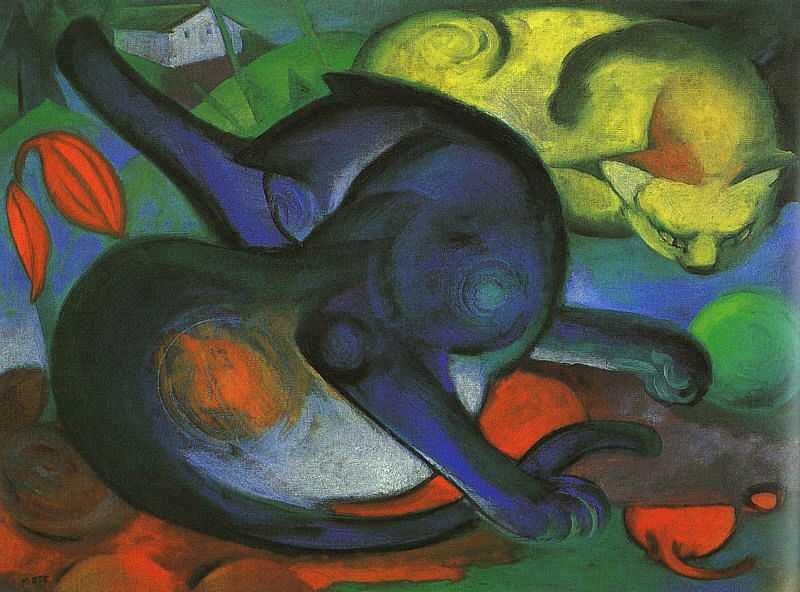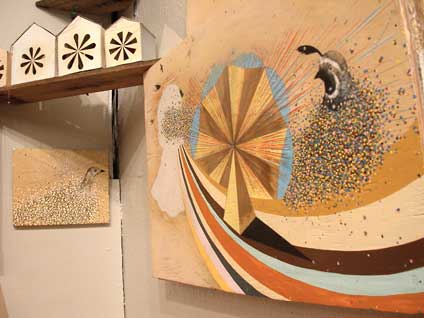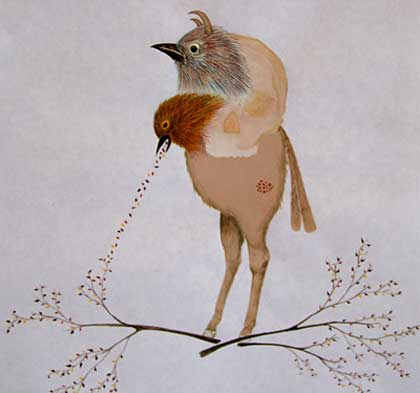
"I am trying to intensify my feeling for the organic rhythm of all things, to achieve pantheistic empathy with the throbbing and flowing of nature's bloodstream in trees, in animals, in the air."
Franz Marc was born on February 8, 1880
Me was born on February 8, 1980
Besides Franz Mark and I having a similar birthday, Marc was an influence to me as an undergrad. He was introduced to me by Prof. Joel Elgin as one of his most influential artists.
Franz Marc is best known for his paintings of animals in non-realistic hues, such as blue and red horses, believing that color had a symbolic and spiritual force all of its own. Blue is the male principle, astringent and spiritual. Yellow is the female principle, gentle, gay and spiritual. Red is matter, brutal and heavy and always the colour to be opposed and overcome by the other two. He liked animals and saw in them innocent beings in harmony with nature. He wanted to paint the world out of the perspective of the animal. Marc was a very sensitive and spiritual man. Today, only hundred years later, it is not quite easy to understand the ideas of this artist and others, although they were documented in articles, books and letters. He met Kandinsky and joined the New Artists Association from which his Expressionists group Der Blaue Reiter later evolved. His work had a mixture of Romanticism, Expressionism and Symbolism
Associated artists: R. Delaunay, Gleizes, Gontcharova, Kandinsky, Kirkeby.

William Wegman makes playful photographs which provide a wry and sophisticated commentary on the absurd elements of contemporary life and human behaviour.

Mark Dion is one of the leading contemporary artists whose work is about animals.
Using props from the natural and man-made world , Dion has constructed an installation that explores contemporary attitudes to science and the environment. He has created a fictional and hybridized situation in which the trappings associated with knowledge, learning and classification-such as books and photographs-are juxtaposed with natural elements including birds and wood. The representation of nature is a fundamental subject in Dions art, and here he takes the role of sociologist/anthropologist and blurring the boundaries between authentic and fake, representation and parody. Dion questions the values of the Western world.
Haunted by the Animal:An article on how Art is continually haunted by the animal.

Arthur Dove liked to paint bulbous forms in strange landscape fantasies while simultaneously resembeling animals and abstract shapes.



Paul Urich 2005


Kiki Smith

Amy Ross 2006
Going Ape: Confronting Animals in Contemporary Art
Going Ape is not the only, first, largest, or last exhibition on the theme of animals in contemporary art. Such shows have appeared throughout the country with increasing frequency over the last several years. This trend reflects two complementary phenomena: a growing set of artists who address animal themes in their work, and an avid audience for animal imagery. Everyone seems to be “going ape” for animal art.
This should come as no surprise. The history of art teems with animals, and may indeed have begun with images of beasts painted on the walls and ceilings of caves. Since that time, animals have appeared in the visual arts in everything ranging from decoration to symbols and allegories. The current interest in animal imagery, as expressed by both artists and viewers, seems intensified by our increasingly uneasy relationships with the natural world and its denizens. Our positions vis-à-vis animals are marked by confrontation and confusion. We gaze with wonder at them in the zoo, yet try to avoid them on the street. Meanwhile, our pets are practically people, since we ask them to be life-long companions and child surrogates. People don’t seem to know animals well anymore, or understand what our interactions should or could mean. This anxiety informs most of the artwork in Going Ape as artists try to find ways to figure out what it means to be animal, human, and both simultaneously.
Among the several themes that run throughout this exhibition are a questioning of the age-old wild/tame dichotomy and a confused duality between human/animal. Artists also use animal imagery to express anxiety and guilt about the wide variety of crimes perpetrated against animals and nature by our own species in the name of Science. But not everything is doom and gloom. Many of today’s artists, like artists throughout history, create images of animals to celebrate their sheer beauty of form, shape, surface, and variety, as well as their animating spirits.
So, even though the art in this exhibition is ostensibly about animals, it’s really all about us: what we think and how we feel. We ultimately confront animals to see ourselves.
Going Ape also heralds the planning, fundraising, and implementation of the Sculpture Zoo, the third phase of DeCordova Museum’s master plan. The Sculpture Zoo will be an area within the Sculpture Park permanently dedicated to the display of contemporary animal sculpture—a new opportunity for children and families to learn about the art of our time.
Going Ape includes work by the following artists:
* Deborah Brown
* Catherine Chalmers
* Walton Ford
* James Grashow
* Catherine Hamilton
* John Harden
* Henry Horenstein
* Mary Kenny
* Vitaly Komar & Alex Melamid
* Neeta Madahar
* Barbara Moody
* Josie Morway
* Gwynn Murrill
* Frank Noelker
* Barbara Norfleet
* Shelley Reed
* Amy Ross
* Peter Smuts
* Brad Story
* Kitty Wales

3 comments:
you are absolutely wonderful, mandy. i don't know if i had anything to do with this post but thank you for doing it. this alone will give me all kinds of avenues to explore and see where i want to dive in as i begin my journey through animals as the subject of my art. thanks again, mandalin. and happy belated b-day.
Franz Marc is my hero
Hey, a baby printmaker tried to sit in your special peyote inspired shop place today - yes - even on this day of love the babies flunked
Post a Comment